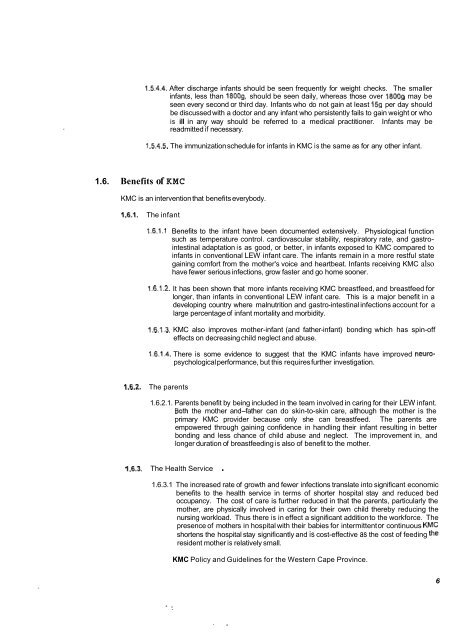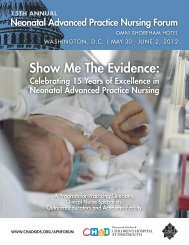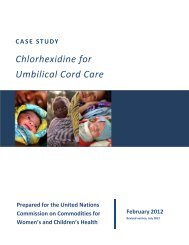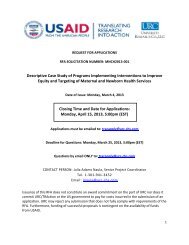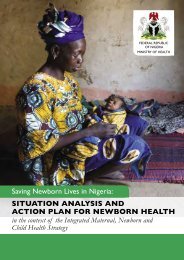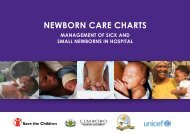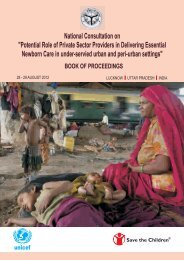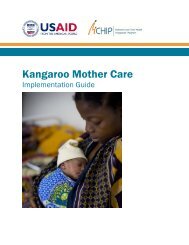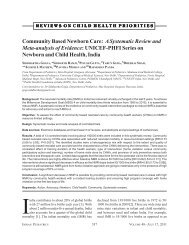Kangaroo Mother Care Policy/Guidelines - Western Cape Government
Kangaroo Mother Care Policy/Guidelines - Western Cape Government
Kangaroo Mother Care Policy/Guidelines - Western Cape Government
You also want an ePaper? Increase the reach of your titles
YUMPU automatically turns print PDFs into web optimized ePapers that Google loves.
1.5.4.4. After discharge infants should be seen frequently for weight checks. The smaller<br />
infants, less than 18OOg. should be seen daily, whereas those over 18009 may be<br />
seen every second or third day. Infants who do not gain at least 159 per day should<br />
be discussed with a doctor and any infant who persistently fails to gain weight or who<br />
is ill in any way should be referred to a medical practitioner. Infants may be<br />
readmitted if necessary.<br />
1.5.4.5. The immunization schedule for infants in KMC is the same as for any other infant.<br />
1.6. Benefits of KMC<br />
KMC is an intervention that benefits everybody.<br />
1.6.1. The infant<br />
1.6.1.1 Benefits to the infant have been documented extensively. Physiological function<br />
such as temperature control. cardiovascular stability, respiratory rate, and gastrointestinal<br />
adaptation is as good, or better, in infants exposed to KMC compared to<br />
infants in conventional LEW infant care. The infants remain in a more restful state<br />
gaining comfort from the mother's voice and heartbeat. Infants receiving KMC also<br />
have fewer serious infections, grow faster and go home sooner.<br />
1.6.1.2. It has been shown that more infants receiving KMC breastfeed, and breastfeed for<br />
longer, than infants in conventional LEW infant care. This is a major benefit in a<br />
developing country where malnutrition and gastro-intestinal infections account for a<br />
large percentage of infant mortality and morbidity.<br />
1.6.1.3. KMC also improves mother-infant (and father-infant) bonding which has spin-off<br />
effects on decreasing child neglect and abuse.<br />
1.6.1.4. There is some evidence to suggest that the KMC infants have improved neuropsychological<br />
performance, but this requires further investigation.<br />
1.6.2. The parents<br />
1.6.2.1. Parents benefit by being included in the team involved in caring for their LEW infant.<br />
Both the mother and-father can do skin-to-skin care, although the mother is the<br />
primary KMC provider because only she can breastfeed. The parents are<br />
empowered through gaining confidence in handling their infant resulting in better<br />
bonding and less chance of child abuse and neglect. The improvement in, and<br />
longer duration of breastfeeding is also of benefit to the mother.<br />
1.6.3. The Health Service .<br />
1.6.3.1 The increased rate of growth and fewer infections translate into significant economic<br />
benefits to the health service in terms of shorter hospital stay and reduced bed<br />
occupancy. The cost of care is further reduced in that the parents, particularly the<br />
mother, are physically involved in caring for their own child thereby reducing the<br />
nursing workload. Thus there is in effect a significant addition to the workforce. The<br />
presence of mothers in hospital with their babies for intermittent or continuous KMC<br />
shortens the hospital stay significantly and is cost-effective as the cost of feeding the<br />
resident mother is relatively small.<br />
KMC <strong>Policy</strong> and <strong>Guidelines</strong> for the <strong>Western</strong> <strong>Cape</strong> Province.<br />
6<br />
. .


